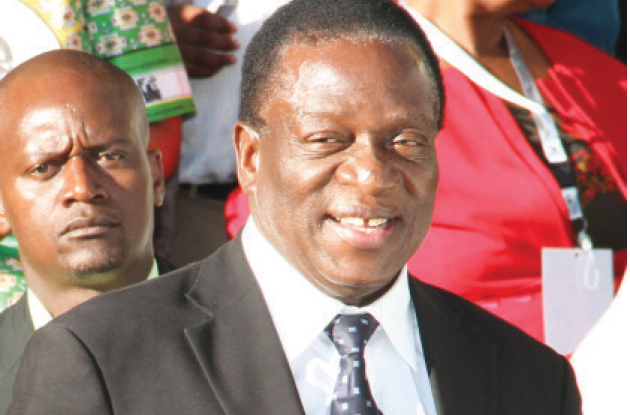Brand ED Mnangagwa shaping up, working

Tichaona Zindoga
A couple of months ago, at the height of the factional fighting in the ruling Zanu-PF, a small study I carried out while in South Africa led me to conclude that the then Vice President Emmerson Mnangagwa who at the time was politically besieged, was also a “victim” of bad public relations (how his relationships with publics have been held) and bad publicity (how he has been covered in the media) which has resulted in and from, equally, bad perception and image management.
I noted that amid skullduggery, Cde Mnangagwa had been associated with characters that were toxic to his brand — as the next President — as some characters purporting to act on his behalf were seen in traditional and social media as pushing a narrow and overwhelmingly negative perception associated with tribalism.
It appeared then that there was little or no attempt to build a brand for the then VP.
In light of the multi-faceted political battle that Cde Mnangagwa faced, it was critical to define his political brand and activate the most appropriate mechanisms of communication to promote an accurate perception of his politics.
Political branding is about how a political organisation or individual is perceived overall by the public.
According to political communication literature, political branding is broader than the product; whereas a product has distinct functional parts such as a politician and policy, a brand is intangible and psychological.
It is said a political brand is “the overarching feeling, impression, association or image the public has towards a politician, political organisation, or nation” which helps a party or politician help change or maintain reputation and support, create a feeling of identity with the party or its candidates and create a trusting relationship between political elites and consumers.
A political brand is understood more quickly.
Looking back at the turbulent era, there was a very scant notion of the brand and this affected a key process called perception.
Perception is defined as the “process by which individuals select, organise, and interpret the input from their senses to give meaning and order to the world around them”.
According to political communication literature, components of perception include the perceiver, target of perception, and the situation.
It is argued that perception is as strong as reality as people tend to believe what they see to be true and may be influenced to either reinforce this perception or change it depending on the strength and agency.
A couple of months on, there is a positive turnaround.
Brand ED Mnangagwa is clearly discernible and perceptions are changing — and changing fast.
President Mnangagwa is winning a lot of support.
He is charming a nation, and the world.
The first level of understanding his image-building and branding efforts is through his speeches.
He has assured Zimbabwe that he is “everyone’s President”.
He said in his inaugural speech on November 24: “My Presidency should not be perceived as a rise in the fortunes of a region, or a tribe or a totem, no. My Presidency is about a united Zanu-PF, a national party with a national outlook.
“I stand before you therefore as the President of a united, non-racial Zimbabwe, itself home to many tongues, dialects, cultures, colours, age groups.
“I am a President of women and men; the young and the old; the able-bodied and the physically challenged; the rich and the poor; the well and the sick. I am an emissary of all the veterans and heroes, dead or alive who through their blood sketched the cause and mission which my Presidency must promote, must actualise and advance.
“I am a President for Ndebeles, Shonas, Zezurus, Ndaus, Karangas, Manyikas, Vendas, the Chewas, Sothos.
“I am also the President for the Tongas, Tswanas, Xhosas, Khoisans, Shangaans, Kalangas, Nambyans and other races, all who are celebrated in our national Constitution.”
This is key to the brand — and he has also acted on it by mainly balancing ethnic composition of leadership around him, something that you would not expect from a tribal leader or, for that matter, a “Midlands godfather”.
Indeed, there have been a number of personalities from Masvingo and Midlands, the so-called Karanga, who sought to play the tribal card and had a sense of entitlement, which has happily not been rewarded.
Cde Mnangagwa’s brand has won a lot of shine, thanks to his recent visit to ailing opposition leader Morgan Tsvangirai.
He has shown to be a compassionate and caring leader and human being.
Juxtapose that with the philanthropic work being done by the First Lady, Auxillia, and a picture of a compassionate and humane new administration becomes fuller.
It is a side that we did not see before the transition.
Cde Mnangagwa’s policies — including cost cutting in travel and spending — have the effect of enhancing a positive brand while pictures of him at work gives us an image of a doer.
There is a perception that Cde Mnangagwa is business-savvy and his appearances at business events or functions — along with manner of dress (talk of cutting on those “Chinese suits”) and speaking — will carry a helpful role in his image and branding.
On the main, Brand ED Mnangagwa is shining and growing fast.
Cde Mnangagwa will have to consistently demonstrate that he is, among other things:
– National leader vs regional/tribal “Godfather”
– Respected rather than feared
– Doer vs rhetorician
– Show compassion, love (Father Figure) vs aloofness and vindictiveness
– Nationalist rather than tribalist
– Forward-looking vs historic
– Proactive vs reactive
– Practical vs aspirational
Back in September, I identified that Brand ED Mnangagwa would also involve: setting up a strategic communication and brand team, pruning off and dissociation with negative/toxic characters, public show of a softer/side (He once said he is soft as wool) and on the main his life story will need to be told to confront historical and personal issues, myths and misconceptions.
The brand of the leader is critical — in this transitional process — as it is tied to perception.
We note that perception can be as strong as reality.
The brand of the national leader will rub off onto Zimbabwe.
The good thing is that a brand is shaping up and positively.
Just consider this comment from a South African newspaper, Sunday Independent: “Emmerson Mnangagwa, the new President of Zimbabwe, is not an ogre with evil intent as his detractors make him out to be. He is a courteous, amiable, honest to goodness person, who is now on a new mission to fix what needs to fixed in his home country so that Zimbabwe can become an asset yet again in the geopolitical region of southern Africa — just as many compatriots would want it to be.”
It will be critical to maintain this kind of vibe.
Margaret Scammel, writing in Journal of Political Marketing in 2015 says:
“The beauty about a political brand as a concept is that it is broad and inclusive; it brings together the rational and the irrational, the hard and soft elements of voter choice, the big dimensions of political reputations and the seemingly trivial details of tone and voice.”











Comments